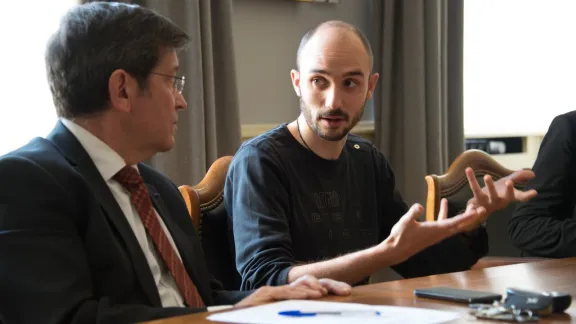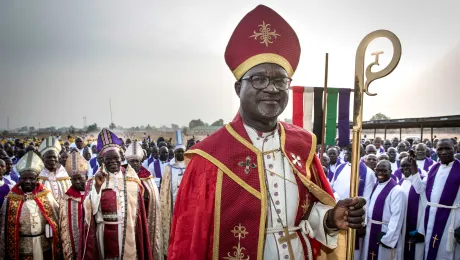
During COP 21 meetings in Paris, Former LWF Climate Justice Advocacy Officer, Martin Kopp, discusses key issues of climate justice with faith leaders and ecumenical partners. Photo: LWF
“With a small hammer, you can achieve great things”, stated French Foreign Affairs Minister Laurent Fabius at the closing of the 21st United Nations (UN) climate change conference COP21 on 12 December 2015 in Paris.
It is indeed by banging a tiny green gavel in the form of a leaf that the President of the conference formally adopted the Paris Agreement. Its ambition is to keep global temperature rise well below 2 °C above pre-industrial levels, to pursue efforts to even stay below 1.5 °C, and to help vulnerable countries and communities adapt and foster their resilience.
Four months later, the world is hoping for a dance of pens. The UN General Secretary has invited all 196 Parties to the UN Climate Framework Convention on Climate Change to New York to officially sign the agreement during a high-level ceremony on 22 April. Do pens also achieve great things?
As a communion of churches, The Lutheran World Federation (LWF) supports this momentum and has added its voice to the choir demanding early ratification and effective implementation, so that vulnerable people are taken care of and no one is left behind. The LWF President and the General Secretary have signed onto the global Interfaith Statement that was handed to the President of the UN General Assembly on 18 April.
The signature of the agreement is the second formal step towards its entry into force. By signing each country will show its support and demonstrate its willingness to move towards ratification, which is the last—but vital—formal step: the agreement will enter into force thirty days after at least 55 countries representing at least 55 % of global greenhouse gas emissions have ratified it.
The warm up
The New York ceremony might then be described as the warming up before the game. But as all sporty people know, a good warm up is a condition for a good game.
And it may well be so. According to the UN, over 130 countries are expected to sign in New York: it would be a record number in the history of signing ceremonies!
Of crucial importance is the recent announcement by the United States and China that they will not only sign the agreement but also take domestic measures to ratify it this year. Together, they account for about 40% of worldwide emissions, making up the most of what is needed to meet one of the two conditions for entry into force.
Add the announcement of India, Brazil and South Africa that they will move towards ratification as soon as possible, the fact that 10 states have already agreed to ratify at the domestic level, the good political momentum, and one is led to this unexpected outcome: the Paris Agreement might enter into force in 2017 or 2018 already, and according to some observers, possibly in 2016!
The global Interfaith Statement
2015 was the hottest year on record. 2016 is set to break new records. Millions are already suffering from the impacts of climate change and new studies are pointing both to the risks and opportunities ahead for our societies and economies. There is no time to waste. The sooner the Paris Agreement enters into force, the higher the chances that it will meet its goals.
Martin Kopp
Former LWF Climate Justice Advocacy Officer


